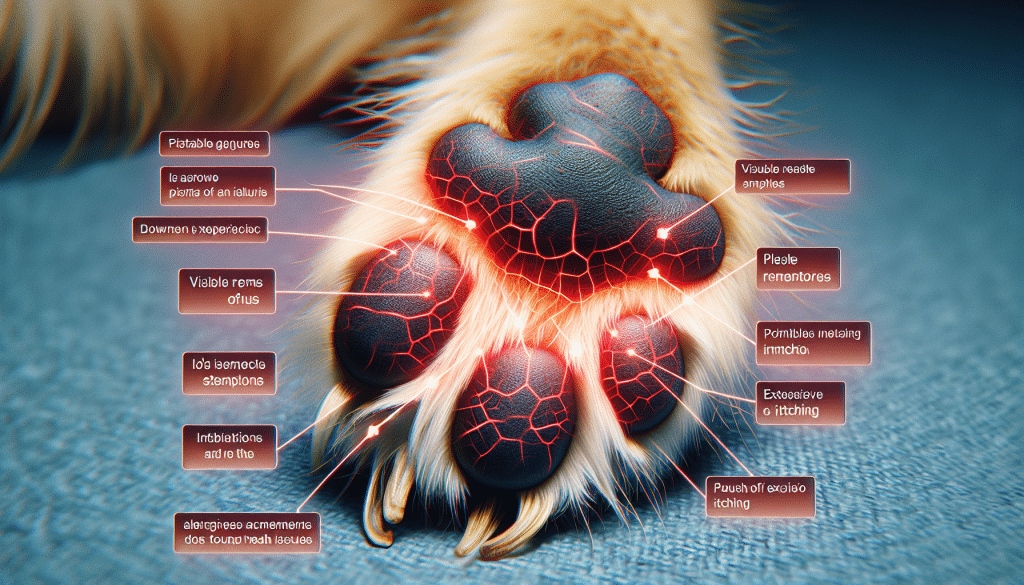If you’re a dog lover, you know that cuddling up with your furry friend is one of life’s greatest joys. But what happens when your own body rebels against this deep bond? Common dog allergies can put a damper on your relationship, leaving you sneezing, itching, and reaching for the tissues. But fear not, because this comprehensive guide is here to help you navigate the world of dog allergies, providing you with the knowledge and strategies you need to manage and overcome these pesky sensitivities. Say goodbye to allergy-induced sniffles and hello to a harmonious life with your four-legged companion.

This image is property of images.pexels.com.
What are Dog Allergies?
Definition of dog allergies
Dog allergies refer to an immune system response in dogs that occurs when their bodies mistakenly identify certain substances, known as allergens, as harmful. These allergens can be inhaled, ingested, or come into contact with the skin, leading to allergic reactions in sensitive dogs.
Types of dog allergies
There are various types of allergies that can affect dogs. These include environmental allergies, food allergies, flea allergy dermatitis, contact allergies, atopic dermatitis, allergies to medications, and seasonal allergies. Each type of allergy has its own triggers and symptoms, requiring different approaches to diagnosis and treatment.
Common symptoms of dog allergies
Dog allergies can manifest in a variety of symptoms, which can vary depending on the type of allergy. Common symptoms include itching, redness, inflammation, sneezing, coughing, runny nose or eyes, ear infections, gastrointestinal issues, hair loss, and skin infections. It is important to recognize these symptoms and seek veterinary care to provide relief and prevent further complications.
Identifying Dog Allergens
Common allergens for dogs
Dogs can be allergic to a wide range of substances. Common allergens for dogs include pollen from grasses, trees, and weeds, mold spores, dust mites, certain foods, such as beef, chicken, wheat, or soy, insect bites or stings, certain fabrics or household chemicals, and even certain medications. Identifying the specific allergens that trigger a dog’s allergies is crucial for effective management.
Testing for dog allergies
To identify the specific allergens affecting a dog, various tests can be conducted by a veterinarian. These may include skin allergy testing, blood tests, or food elimination trials. Skin allergy testing involves exposing a dog’s skin to small amounts of different allergens to determine which ones elicit a reaction. Blood tests can measure the levels of specific antibodies associated with allergies. Food elimination trials involve systematically removing certain foods from a dog’s diet to identify potential food allergies.
Reading dog allergy test results
Understanding the results of dog allergy tests requires the expertise of a veterinarian. In the case of skin allergy testing, the veterinarian will examine the dog’s skin reactions to different allergens and note the severity of each reaction. Blood test results will indicate the levels of specific antibodies associated with certain allergens. By interpreting these results, the veterinarian can identify the specific allergens affecting the dog and devise an appropriate treatment plan.

This image is property of images.pexels.com.
Environmental Allergies
Causes of environmental allergies
Environmental allergies in dogs are primarily caused by exposure to airborne allergens, such as pollen, mold spores, or dust mites. These allergens can enter a dog’s respiratory system, leading to an immune system response and subsequent allergic reactions. Environmental allergies can also be influenced by factors like climate, seasonality, and the presence of certain plants or vegetation in the surroundings.
Preventing environmental allergies
While it may not be possible to completely prevent a dog from encountering environmental allergens, there are steps that can be taken to reduce exposure and minimize allergic reactions. Keeping the dog’s living area clean and free from dust or mold, using air purifiers, avoiding areas with high pollen counts, and regularly bathing the dog using hypoallergenic shampoos can help alleviate environmental allergies. Additionally, avoiding exposure during peak allergy seasons can also be beneficial.
Treating environmental allergies
Treating environmental allergies often involves a combination of approaches to provide relief to affected dogs. This can include antihistamines to reduce itching and inflammation, corticosteroids to control severe reactions, allergy shots (immunotherapy) to desensitize the dog’s immune system, and topical treatments to soothe irritated skin. In some cases, dietary supplements and fatty acid supplements may also be recommended to support the dog’s skin and immune health.
Food Allergies
Causes of food allergies in dogs
Food allergies in dogs occur when the immune system reacts negatively to certain ingredients in their diet. Common causes of food allergies in dogs include proteins such as beef, chicken, lamb, or fish, grains like wheat or corn, dairy products, eggs, and soy. Food additives and preservatives can also trigger allergic reactions in some dogs. Food allergies can develop at any age, and dogs may suddenly become sensitive to ingredients they have previously tolerated.
Identifying food allergies
Identifying food allergies in dogs can be challenging as the symptoms can often overlap with other allergies. The most effective method is to conduct a food elimination trial, which involves feeding the dog a novel protein and carbohydrate source that they have not been exposed to before. If symptoms improve or disappear during the trial, and reappear when the previous diet is reintroduced, it indicates a food allergy. Consultation with a veterinarian and strict adherence to the elimination trial protocol is essential for accurate diagnosis.
Elimination diets for food allergies
Elimination diets involve feeding a dog a restricted diet consisting of a single novel protein source (e.g., venison, duck) and a carbohydrate source (e.g., sweet potato, pea) for a period of 8-12 weeks. During this time, no other treats or flavored medications should be given to accurately determine if food allergies are the cause of the dog’s symptoms. This method helps identify the specific ingredient triggering the dog’s allergies and allows for the formulation of an appropriate long-term diet plan.

This image is property of images.pexels.com.
Flea Allergy Dermatitis
Understanding flea allergy dermatitis
Flea allergy dermatitis (FAD) is a common allergic skin condition in dogs that occurs as a result of an allergic reaction to flea saliva. Dogs who are hypersensitive to flea saliva can experience severe itching and discomfort even from a single flea bite. The saliva triggers an immune response, causing an allergic reaction characterized by redness, inflammation, and intense itching.
Preventing flea allergies
Preventing flea allergies in dogs involves implementing a comprehensive flea control program. This includes regular use of flea prevention products, such as topical treatments or oral medications, to kill and repel fleas. It is important to keep the dog’s living areas clean, regularly wash bedding, vacuum often, and maintain proper hygiene practices. Additionally, avoiding areas where fleas are known to be prevalent and ensuring the dog’s playmates are flea-free can help prevent flea infestations.
Treating flea allergy dermatitis
Treating flea allergy dermatitis involves a two-pronged approach: eliminating fleas from the dog and providing relief for the allergic symptoms. Immediate flea removal is crucial to halt the allergic reaction, and this can be achieved by using flea treatments recommended by a veterinarian. To address the allergic symptoms, anti-inflammatory medications, topical creams, soothing baths, and hypoallergenic shampoos can be utilized. Regular grooming and checking for fleas or flea dirt can also aid in early detection and prompt treatment.
Contact Allergies
Common causes of contact allergies
Contact allergies are hypersensitivity reactions that occur when a dog’s skin comes into direct contact with substances to which it is allergic. Common causes of contact allergies include certain plants, fabrics, cleaning products, pesticides, metals, rubber, and plastic materials. These allergies typically result in localized reactions on the areas of skin that have come into contact with the allergen.
Identifying contact allergies
Identifying contact allergies in dogs requires careful observation and knowledge of the substances that the dog comes into contact with regularly. Symptoms of contact allergies may include redness, swelling, itching, blisters, or lesions in the affected areas. By identifying the potential allergens in the dog’s environment and eliminating or avoiding their contact, it is possible to minimize or prevent allergic reactions.
Managing contact allergies
Managing contact allergies involves minimizing the dog’s exposure to the allergens causing the reaction. This can be achieved by removing or reducing contact with the substances triggering the allergy, such as using hypoallergenic bedding or clothing materials, avoiding exposure to certain plants or cleaning products, and using pet-friendly products. In some cases, topical treatments, soothing ointments, or medicated shampoos may be recommended by a veterinarian to alleviate symptoms and promote healing.

Atopic Dermatitis
Causes of atopic dermatitis
Atopic dermatitis is a chronic allergic skin condition in dogs that is typically associated with environmental allergens. It occurs when a dog’s immune system overreacts to certain allergens, such as pollen, dust mites, molds, or dander. The underlying cause of atopic dermatitis is a combination of genetic predisposition and exposure to environmental allergens.
Symptoms of atopic dermatitis
Symptoms of atopic dermatitis in dogs can include persistent itching, scratching, biting, rubbing, hair loss, recurrent skin infections, redness, inflammation, and the development of scaly or crusty lesions. Dogs with atopic dermatitis may also experience secondary ear infections, eye irritation, or respiratory issues due to their allergies. These symptoms can significantly impact a dog’s quality of life and require proper management for relief.
Treatment options for atopic dermatitis
The management of atopic dermatitis in dogs often involves a multifaceted approach to address both the symptoms and the underlying cause. Treatment options may include the use of antihistamines, corticosteroids, or immunosuppressive drugs to relieve itching and inflammation. Allergen-specific immunotherapy, commonly known as allergy shots, can be administered to desensitize the dog’s immune system to specific environmental allergens. Furthermore, regular bathing with medicated shampoos and emollients can help soothe the skin and reduce bacterial and yeast overgrowth.
Allergic Reactions to Medications
Types of medications that can trigger allergies
Just like humans, dogs can also experience allergic reactions to certain medications. Some common medications that can trigger allergies in dogs include antibiotics, nonsteroidal anti-inflammatory drugs (NSAIDs), vaccines, topical flea treatments, and certain types of anesthesia. Allergic reactions to medications can range from mild skin irritations to severe symptoms like difficulty breathing, swelling, or anaphylactic shock.
Recognizing allergic reactions to medications
Recognizing allergic reactions to medications in dogs can sometimes be challenging, as the symptoms may resemble other conditions or allergies. Signs of a medication allergy can include hives, rash, itching, facial swelling, vomiting, diarrhea, difficulty breathing, or collapse. If a dog develops any of these symptoms after being given medication, it is crucial to seek immediate veterinary attention and inform the veterinarian about the suspected allergic reaction.
Managing allergies to medications
Managing allergies to medications in dogs involves avoiding the specific medications that trigger the allergic reactions. It is important to notify veterinarians about any previous medication allergies a dog has experienced to ensure they are not prescribed those medications again. Alternative medications or treatment options may be considered in such cases. In severe allergic reactions, emergency medical treatment may be necessary, including administration of antihistamines, steroids, or other emergency medications.
Seasonal Allergies
Causes of seasonal allergies in dogs
Seasonal allergies, also known as hay fever or allergic rhinitis, in dogs are primarily caused by airborne allergens that are more prevalent during specific seasons. These allergens can include pollen from grasses, trees, or weeds, as well as molds or other fungi that thrive in certain weather conditions. Dogs can develop seasonal allergies due to sensitivity to one or more of these allergens during their peak seasons.
Signs of seasonal allergies
Signs of seasonal allergies in dogs can be similar to other types of allergies and may include itching, redness, inflammation, sneezing, coughing, runny nose or eyes, paw chewing, and generalized discomfort. Additionally, dogs with seasonal allergies may exhibit signs of seasonal dermatitis, such as excessive scratching, hot spots, or ear infections. Monitoring the timing and recurrence of these symptoms can help identify the presence of seasonal allergies.
Treatment options for seasonal allergies
The management of seasonal allergies in dogs often focuses on symptom relief and minimizing exposure to the allergens. Antihistamines, medicated shampoos, and anti-itch creams can be used to alleviate itching and inflammation. Regular bathing to remove allergens from the dog’s coat, wiping paws after outdoor activities, and maintaining a clean living environment can also help reduce allergic reactions. In some cases, veterinary-prescribed immunotherapy may be recommended to desensitize the dog’s immune system to specific seasonal allergens.
Home Remedies for Dog Allergies
Natural remedies for dog allergies
While home remedies cannot replace veterinary care, there are some natural remedies that can provide temporary relief for dogs with allergies. These include oatmeal baths to soothe itchy skin, topical application of aloe vera gel or coconut oil to reduce inflammation, and the use of herbal supplements like chamomile or nettle to support the immune system. However, it is important to remember that the effectiveness of these remedies can vary, and it is always recommended to consult with a veterinarian before trying any home remedies.
Benefits and risks of home remedies
Home remedies can offer some soothing relief for dogs with allergies, and they generally carry fewer side effects compared to certain medications. They can be a cost-effective and easily accessible option for short-term relief. However, it is essential to exercise caution and recognize that not all home remedies are suitable for every dog or every type of allergy. Some substances or remedies can potentially worsen allergic reactions or interact with existing medications. It is best to seek professional advice to ensure the safety and efficacy of any home remedies used.
Consulting a veterinarian before using home remedies
Before starting any home remedies for dog allergies, it is crucial to consult with a veterinarian. They can provide expert guidance on appropriate remedies based on the dog’s specific condition and medical history. In some cases, home remedies may not be sufficient to manage the severity of the allergies, and veterinary intervention may be necessary. A veterinarian’s knowledge and experience can help ensure the most effective and safe management of dog allergies while minimizing discomfort and potential complications.
In conclusion, dog allergies can manifest in various forms and have different triggers. Identifying the allergens and understanding the specific type of allergy is essential for proper diagnosis and effective management. By recognizing the symptoms, implementing preventive measures, and following appropriate treatment options, dog owners can enhance their pet’s comfort and overall well-being. Always consult with a veterinarian for accurate diagnosis and guidance in managing dog allergies.


12 comments
[…] Similar to humans, dogs can undergo skin tests to identify potential food allergies. In this procedure, small amounts of allergens are applied to your dog’s skin, and any allergic reactions, such as redness or swelling, are monitored. Skin tests can provide valuable information about your dog’s allergens and help guide their dietary management. […]
[…] occur when they are hungry, need to go outside, or when they are experiencing physical discomfort. Understanding the context and accompanying body language can help you address your dog’s needs […]
[…] dogs may have specific dietary needs or sensitivities. If your dog has allergies or intolerances, consider hypoallergenic or limited ingredient diets. There are also specialized […]
[…] allergies and sensitivities are common among dogs, and grains are often among the culprits. Many dogs are allergic to ingredients like wheat, corn, […]
[…] friend is protected from potential hazards and provided with all the necessary comforts. In this comprehensive guide, we will go over various aspects of creating a safe and comfortable home environment for your […]
[…] the labyrinth of ingredients and nutritional information. By the end, you’ll have a clearer understanding of what goes into your dog’s food bowl and how to make informed choices for their health and […]
[…] each season, you can ensure that your dog remains happy and healthy throughout the year. In this comprehensive guide, we will explore the various aspects of seasonal dog care, including proper nutrition, regular […]
[…] clear house rules from the beginning will help your new dog understand what is expected of them. Decide where your dog is allowed to go in the house and where they are […]
[…] essential items that every new pet owner should have on hand. In this article, we will provide a comprehensive guide to the must-have dog care products that will help ensure your new pup’s happiness and […]
[…] terriers to larger and more sedentary breeds, let’s dive into the fascinating world of understanding the nutritional needs of different dog […]
[…] impact on a dog’s physical health, immunity, and susceptibility to various ailments. Understanding and addressing mental health concerns is crucial for maintaining your dog’s overall happiness and ensuring their […]
[…] that your pet may be doing this at home. With our expert insight, you’ll have a better understanding of what your dog is trying to tell […]
Comments are closed.